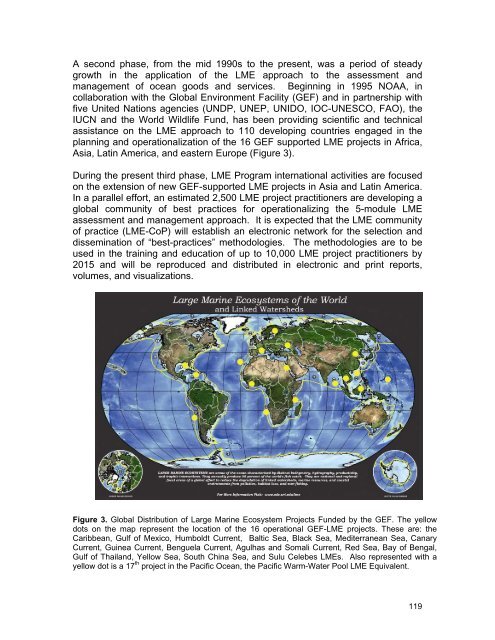Sustaining the World's Large Marine Ecosystems
Sustaining the World's Large Marine Ecosystems
Sustaining the World's Large Marine Ecosystems
Create successful ePaper yourself
Turn your PDF publications into a flip-book with our unique Google optimized e-Paper software.
A second phase, from <strong>the</strong> mid 1990s to <strong>the</strong> present, was a period of steady<br />
growth in <strong>the</strong> application of <strong>the</strong> LME approach to <strong>the</strong> assessment and<br />
management of ocean goods and services. Beginning in 1995 NOAA, in<br />
collaboration with <strong>the</strong> Global Environment Facility (GEF) and in partnership with<br />
five United Nations agencies (UNDP, UNEP, UNIDO, IOC-UNESCO, FAO), <strong>the</strong><br />
IUCN and <strong>the</strong> World Wildlife Fund, has been providing scientific and technical<br />
assistance on <strong>the</strong> LME approach to 110 developing countries engaged in <strong>the</strong><br />
planning and operationalization of <strong>the</strong> 16 GEF supported LME projects in Africa,<br />
Asia, Latin America, and eastern Europe (Figure 3).<br />
During <strong>the</strong> present third phase, LME Program international activities are focused<br />
on <strong>the</strong> extension of new GEF-supported LME projects in Asia and Latin America.<br />
In a parallel effort, an estimated 2,500 LME project practitioners are developing a<br />
global community of best practices for operationalizing <strong>the</strong> 5-module LME<br />
assessment and management approach. It is expected that <strong>the</strong> LME community<br />
of practice (LME-CoP) will establish an electronic network for <strong>the</strong> selection and<br />
dissemination of “best-practices” methodologies. The methodologies are to be<br />
used in <strong>the</strong> training and education of up to 10,000 LME project practitioners by<br />
2015 and will be reproduced and distributed in electronic and print reports,<br />
volumes, and visualizations.<br />
Figure 3. Global Distribution of <strong>Large</strong> <strong>Marine</strong> Ecosystem Projects Funded by <strong>the</strong> GEF. The yellow<br />
dots on <strong>the</strong> map represent <strong>the</strong> location of <strong>the</strong> 16 operational GEF-LME projects. These are: <strong>the</strong><br />
Caribbean, Gulf of Mexico, Humboldt Current, Baltic Sea, Black Sea, Mediterranean Sea, Canary<br />
Current, Guinea Current, Benguela Current, Agulhas and Somali Current, Red Sea, Bay of Bengal,<br />
Gulf of Thailand, Yellow Sea, South China Sea, and Sulu Celebes LMEs. Also represented with a<br />
yellow dot is a 17 th project in <strong>the</strong> Pacific Ocean, <strong>the</strong> Pacific Warm-Water Pool LME Equivalent.<br />
119









